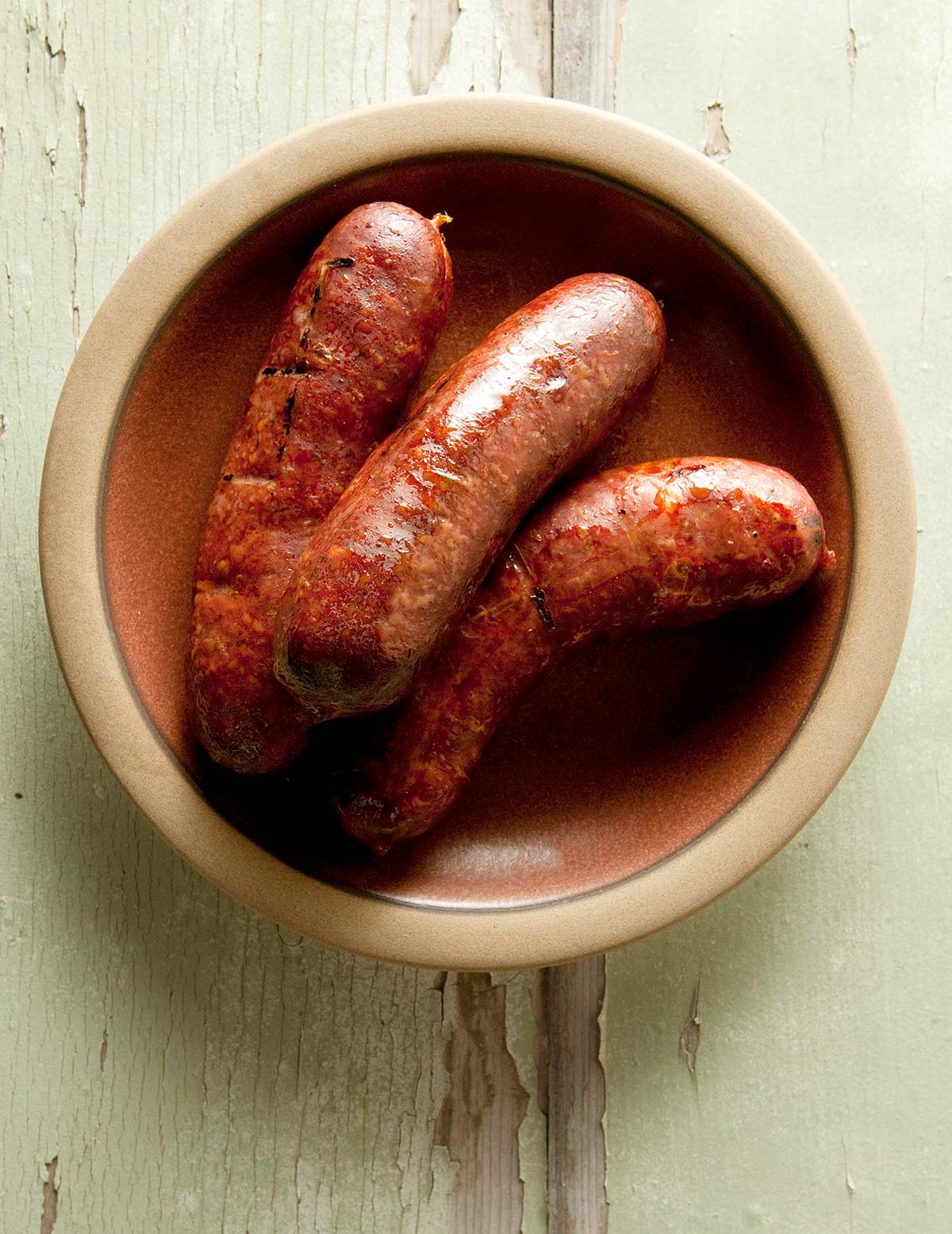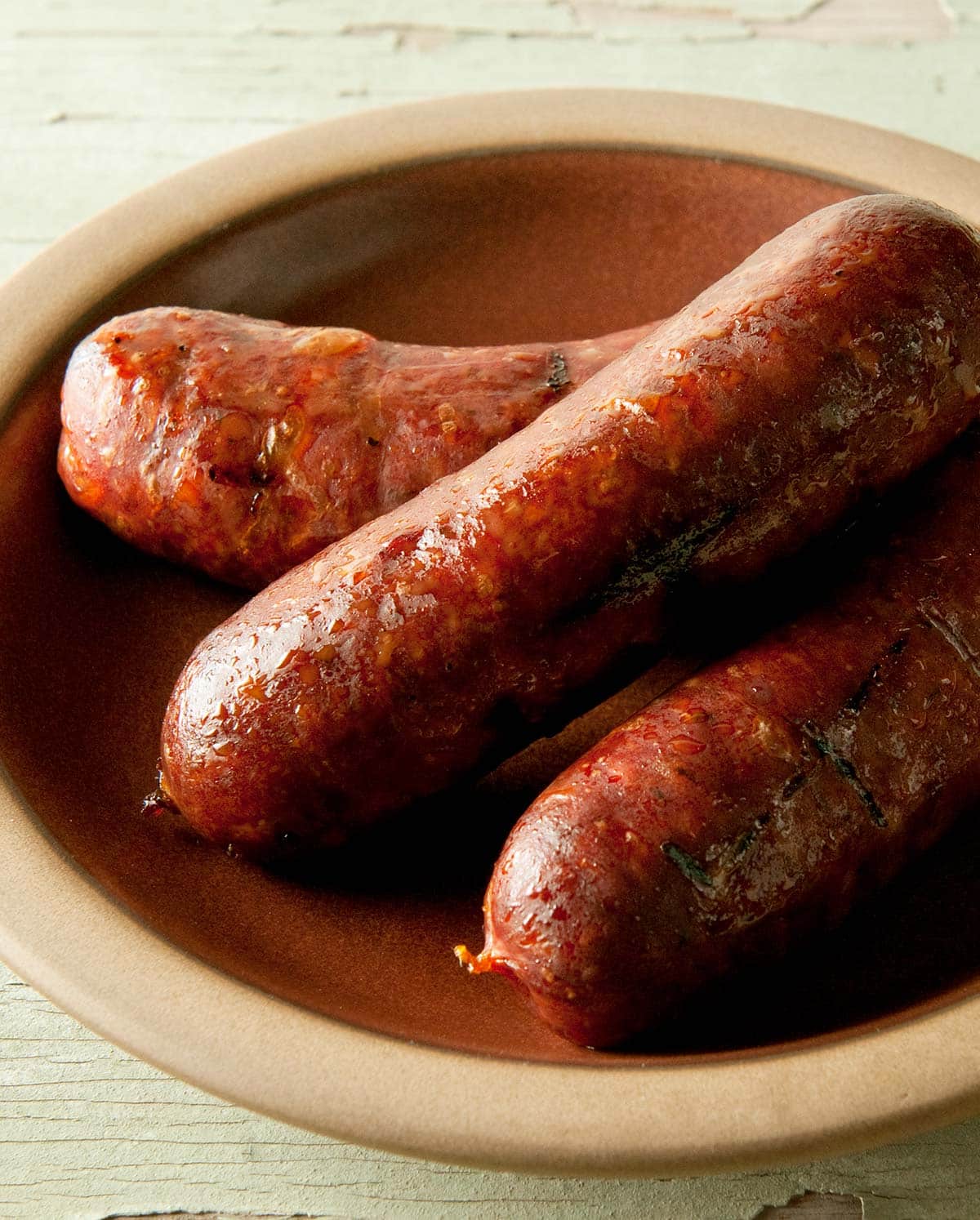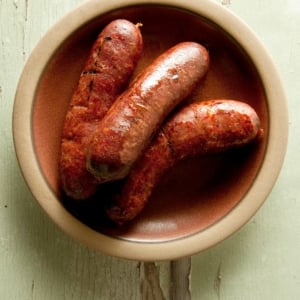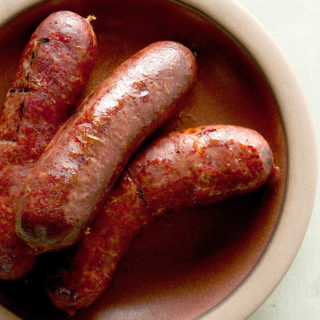Andouille Sausage Links, Cajun Style
March 21, 2012 | Updated September 04, 2022
As an Amazon Associate I earn from qualifying purchases.
Along with the hot dog, Louisiana andouille sausages are quintessentially American. Here’s a traditional recipe for making them at home.

And like the hot dog, andouille sausage too owes at least part of its origins to Germans, even though with a French name it sounds counterintuitive. So far as I can tell, Louisiana-style andouille sausages are a product of early German immigration — and when I mean early I mean the 1750s, when Louisiana was part of France.
France still has versions of andouille, but the American variety has been evolving independently for centuries, and no longer resembles its ancestors.
What Makes Andouille Unique?
Andouille sausage is a Cajun creation, most at home in southern Louisiana, but it also appears a lot in New Orleans Creole cooking, too. It is almost always smoked and heavily seasoned. Typically andouille is seasoned with garlic, cayenne or other hot chiles, black pepper and usually thyme. Sometimes cooked onions appear in the mix.
Remember, there are as many versions as there are cooks, and Louisianans guard their recipes closely. (Note: If you are looking for that other quintessential Cajun sausage, boudin, my recipe for that is here.)
Andouille is chunky, too. Some cooks hand mince everything and stuff that into casings, which is cool, but very labor intensive. I prefer to hand mince about a quarter of the meat and fat, then grind the rest through a coarse die of about 7 or 8 mm.
The other unique thing about andouille sausage is how it is smoked. In Cajun country, andouille is smoked over spent sugar cane stalks after they’ve been pressed for sugar, hackberry wood or pecan — or a combination of the three. For home cooks, pecan is the easiest to obtain.

What Meat is in Andouille?
Normally andouille is a 100 percent pork sausage, but my homemade version is a mix of venison and pork. Why? It’s what I had lying around in the freezer. Frankly, andouille is so heavily spiced and smoked you can make it with whatever meat you have on hand.
I’ve seen andouille made with rabbit and gator, venison, beef, you name it. Cajuns are resourceful and thrifty. But pork fat is key: I’ve never seen or heard of an andouille sausage that didn’t have pork fat in it, regardless of the other meats.
How to Use Andouille Sausage
There is no reason you can’t just eat an andouille sausage: A link served on a bun with green peppers, minced celery, onions and Creole mustard would be damn good — Cajun hot dog! But it is typically tossed into other dishes, like gumbo or jambalaya.
Andouille shows up as an accent in lots of dishes, from the aforementioned gumbo and jambalaya to courtbullion, etouffée, shrimp and grits and sometimes sauce piquante.
Once smoked, andouille sausage lasts in the fridge a week or so, and it freezes very well. Remember these will be cooked sausages, so once you decide to use your andouille you’ll just be reheating them, not cooking them.
For hunters: If you are starting with frozen wild game, you can thaw it, make these sausages, smoke the links and then refreeze them. So long as you cook them to an internal temperature of at least 150°F, the texture of the sausages will not suffer too much.
Cajun Andouille Sausage
Ingredients
- 3 1/2 pounds venison, pork, beef or other meat
- 1 1/2 pounds pork belly or fatty shoulder
- 33 grams kosher salt, about 3 tablespoons
- 4 grams Instacure No. 1, about a teaspoon
- 3 tablespoons minced fresh garlic
- 2 teaspoons cayenne
- 2 tablespoons sweet paprika
- 2 teaspoons dried thyme
- 1/2 cup ice water or beer (put in fridge to keep it cold)
- Hog casings
Instructions
- Take about 10 to 15 feet of casings (typically three lengths) and submerge them in warm water.
- Cut the meat and fat into chunks and toss with the salt, Instacure, garlic, cayenne, paprika and thyme. You need the Instacure No. 1 as a safety measure when you smoke the links; if you don't plan on smoking them, you need not use this. Put everything in a container and freeze for 30 minutes to 1 hour, or until the mixture is 35°F or colder. You can also put the mix in the fridge overnight; this will help the bind.
- Grind everything through the coarse die, 7 or 8 mm. Andouille is most typically a country-style, coarse sausage. If you want, you can even hand-mince the meat yourself. If you want to do this, hand mince 1/4 of the meat and fat mixture to get a more interesting texture for your sausage.
- Make sure the mixture is very cold, about 30°F; you will probably need to freeze it again for a while. When it's cold enough, take it out and add the chilled water or beer to the bowl and mix on the lowest setting for 90 seconds to 2 minutes, or with your very clean hands for 2 minutes. The look of the meat will change as it binds to itself, and will look more like thick batter than ground meat and fat.
- If you are making patties, you're done. Store each patty between pieces of wax paper and then wrap tightly in plastic wrap, then foil, before freezing. If you are making links, load up a sausage stuffer with the meat and fat. Rinse the casings by running warm water through them: You want to flush some salt and check for any holes in the casings. Thread an entire casing onto the stuffer and fill it slowly. Coil the filled casing as you go. Fill all the casings before making individual links.
- To make individual links, tie off one end of a casing. Compress the sausage inside it to fill that end link. Pinch off a link and flip it away from you several times to tighten it. Move down the coil and pinch down another link. This time, flip the link back toward you to tighten it. (Here's a quick video on making the links) Repeat this process down the coil until you get to the end. Tie off the end link. Repeat with all the other casings.
- Hang your sausages to dry for an hour or more. Hang for 1 to 2 hours at room temperature, or up to overnight where your temperatures are below 45°F. I use a standard clothes drying rack to hang my links. When the sausages are hanging, use a large needle to pierce any spots on the links where there is air trapped underneath. Sterilize the needle in the flames of a gas burner or with a lighter until it glows. You need to pierce any trapped air or your links could burst when you cook them.
- Once the sausages have hung, smoke them over pecan wood for 3 to 4 hours. If you hot-smoke your links, pull them when they reach an internal temperature of 155°F. If your links don't get to that temperature in time, you can either smoke them longer, or you can finish the cooking in an oven set at 200°F. Once they're fully cooked, let them cool before freezing.
Nutrition
Nutrition information is automatically calculated, so should only be used as an approximation.







First, I love your site and the recipes are great. My question for this recipe and many others calling for your short cures (cure #1), couldn’t I just cold smoke them around that 50 degree mark overnight and then finish them off either with hot smoke or in a dish?
As long as they were cooked after, I could also freeze them immediately after the cold smoking?
I made some with goose leg meat minus the Instacure….and smoked them over applewood with stovepipe porter beer. Wow!
Anthony: Yep. I’ve done it. Duck + pork fat = good eats!
Could you use duck for this ?
Andrew
CURE #1
Some Other Names:
Pink Salt;
Tinted Cure Mix (TCM);
Tinted Curing Powder (TCP);
Prague powder #1;
InstaCure #1;
Modern cure;
D.Q. powder;
FLP;
L.E.M. cure;
Sure Cure;
Fast Cure;
Speed Cure
This premix is use in meats and sausages that require a short curing time, and will be smoked, cooked or canned. It is a blend of salt and sodium nitrite, and of course it has the curing properties of sodium nitrite. The salt is added as a carrier and to make it easier to measure. In the United States it is dyed pink, so chefs and the home user will not mistake it for salt or sugar. Though it goes by several different brand and generic names, they all have the same formula of 93.75% salt, and 6.25% sodium nitrite (1 pound of salt plus 1 ounce of sodium nitrite).
Cure #1 can be used as a dry brine (dry cure) or in a wet brine (pickle). It provides the same curing properties of sodium nitrite, and is considered a quick cure, because it starts curing immediately upon contact with the meat. As mentioned earlier, this type of cure is used for curing meats for a short period of time that will be cooked, smoked, or canned. This includes poultry, fish, ham, bacon, luncheon meats, corned beef, pates, sausages and other products too numerous to mention.
NOTE: This is not interchangeable with cure #2, or any of the Morton brand name cures. Also do not mistake this for recipes calling for sodium nitrite, which means pure sodium nitrite.
Use as directed, more is not better and it can be toxic. To ensure that the cure is distributed more evenly in your sausage, mix it with the liquid that your recipe calls for, or mix it with the meat prior to grinding.
Use as follows:
Cure per pound of ground meat/fat:
Amount of Meat/Fat Amount of Cure
Vol. Wt.
1 lb. 1/4 tsp. .05 oz.
2 lbs. 3/8 tsp. .08 oz.
3 lbs. 1/2 tsp. .10 oz.
4 lbs. 3/4 tsp. .15 oz.
5 lbs. 1 tsp. .20 oz.
10 lbs. 2 tsp. .40 oz.
15 lbs. 1 Tbsp. .60 oz.
20 lbs. 1 Tbsp. + 1 tsp. .80 oz.
25 lbs. 1 Tbsp. + 2 tsp. 1.00 oz.
50 lbs. 3 Tbsp. + 1 tsp. 2.00 oz.
100 lbs. 6 Tbsp. + 2 tsp. 4.00 oz.
CURE #2
Some Other Names:
Prague powder #2;
InstaCure #2;
Modern cure #2;
D.Q. powder #2
his cure is a blend of salt and sodium nitrite and sodium nitrate. The salt is added as a carrier and to make it easier to measure. In the United States it is dyed pink, so chefs and the home user will not mistake it for salt or sugar. It goes by several different brand and generic names, but they all have the same formula of 89.75% salt, and 6.25% sodium nitrite, and 4% sodium nitrate (1 pound of salt, plus 1 ounce of sodium nitrite, plus .64 ounce of sodium nitrate).
Cure #2 has the same curing and food preservative properties as sodium nitrite, and the extended curing time of sodium nitrate. It is specifically formulated to be used for making uncooked dry cured products that require several weeks to several months to cure. Dry curing meat or sausage properly cannot be done with Cure #1 which contains sodium nitrite only; it dissipates too quickly.
Cure #2 can be compared to the time release capsules used in medicines – the sodium nitrites start working immediately, while the sodium nitrates slowly reduce over time into sodium nitrites. Thus allowing for the much longer curing times required to dry cure, which can take up to 6 months. Generally used in such sausages as pepperoni, hard salami, geonoa salami, prosciutto hams, dried farmers sausage, capicola and others that do not require cooking, smoking, or refrigeration.
NOTE: This is not interchangeable with cure #1, or by any of the Morton brand name cures. Nor is it interchangeable with sodium nitrate or saltpeter which is measured differently and has different curing times. Also do not mistake this for recipes calling for sodium nitrate or sodium nitrite, which means pure sodium nitrate or pure sodium nitrite.
How to Use: Measures the same as cure #1 (see above).
Use as directed, more is not better and it can be toxic. To ensure that the cure is distributed more evenly in your sausage, mix it with the liquid that your recipe calls for, or mix it with the meat prior to grinding.
Just as cure #1, when using cure #2 additional salt needs to be added to your sausage. Cure #2 can be used as a dry brine (cure) or in a wet brine (pickle).
Now this recipe excites me a lot! I’m gonna have to make it this coming weekend for sure.
Hank, love reading your blogs. First time to post. I thought what made an andouille an andouille was the grain of meat used, or less processed. I’m from Louisiana and I’m working in Illinois. I laugh when people pronounce it (anduelly).The L is silent. ; )
Andrew: No. One is sodium nitrate, the other is sodium nitrite. You cannot use them interchangeably.
Couldn’t you substitute Instacure #2 for #1, but not vice versa, so long as the salt bill wasn’t too high?
Generally, yes you can. It has enough nitrites to cure the sausage or corned beef (etc) and the nitrates won’t hurt anything. It’s not the best practice but it will work. But if I recall correctly, you cannot use #2 in bacon because bacon is cooked at much higher temperatures and the nitrates create nitrosamines (sp?) during cooking.
If you’re making salami (not summer sausage) and other things that cure for a very long time before cooking, you need to use #2. If it’s a good recipe, it will tell you the right cure to use.
You may have just bumped 4 or 5 things of my list to make to add these sausages.
Fishguy: No, you can’t substitute. Instacure No. 2 is for long-cured products. It is like a time-release pill in that it slowly protects the meat by releasing nitrite over time. Instacure No. 1 is nitrite, Instacure No. 2 is nitrate. Nitrate degrades over time into nitrite. Do not mix the two.
Hank,
these look great! Can I use instacure #2 inplace of #1?
Kevin: It would work perfectly, I suspect. Just skin those ducks, remove all the fat, and replace it with sweet, delicious pork fat!
I pound a lot of ducks in my hood, I’m always looking for another fun way to use the “fish eaters’… What are your thoughts on making Andouille sausage with duck and pork?
Oh man Hank, you’ve got me drooling. I love New Orleans cuisine and andouille is near the top of the list. If I’m not mistaken, there are a lot of similarities between andouille and linguica no? A little more of this and a little less of that possible to tweak to the Portuguese palate?
Tom’s comment above is right on the money. Rabbit would make a fantastic gumbo. I’ve had it with pigeon as well which ROCKED. Make your roux DARK though to stand up to the flavor of the meat.
Here’s a couple of ideas from my blog for something to do with that andouille if you grow weary of eating it straight:
Jambalaya: https://thedamntrueexperiment.blogspot.com/2012/03/man-can-cook-17-jump-out-da-gym.html
Gumbo: https://thedamntrueexperiment.blogspot.com/2011/05/man-can-cook-9-gumbo-du-fontenot.html#more
I’m pretty sure Jackrabbit and andouille would make a fine gumbo! Just saying!
Some day I’d love to get into making my own sausage, I really would. That’s even more true after seeing those gorgeous beauties up there. I need my daughter to grow up a little more first though. Saving the recipe for sure! Many thanks.
I love seeing all the variations. I use red wine vinegar instead of wine or beer, more paprika, a little chopped italian parsley, and no milk powder. Then hot smoke it. Sometimes I’ll add in some chopped roasted red bell pepper too, just for kicks.
Andrew: True dat. But you need a quality grinder to do it. I’ve found the Kitchenaid grinder not up to the task.
Beauty.
On a whim, I ran untrimmed venison through a good sharp hand grinder yesterday (a foreleg shank) and it was a beautiful thing. Point being, silverskin isn’t as big a deal as one would think if the grinder has the teeth and balls to cut it. It makes the sausage a lot richer and gives a better snap on the bite. I ran beef neck tendon through a grinder along with some other trim and it really added to the recipe’s texture.
Great recipe. I asked several people from Southern Louisiana how they made Andouille and got a few common responses. The German Cajuns use hog maws or stomach sometimes exclusively. The Pork or mixed versions at least half of the meat was hand sliced into about 1/2″ chunks, some would pound the rest with a meat cleaver to tenderize and partially grind it. The sweet spices varied and some used none at all.
One point that was almost universal was that the sausages should be smoked over Bagasse, the left over stalks of sugar cane after pressing. Hackberry was the most common wood for smoking but others would add pecan, fruit wood or hickory if available. If lightly and slowly smoked the sausage will take on a reddish black color to the casing and a bit of sweetness from the cane smoke.
I have replicated the Bagasse with chunks of fresh sugar cane on the fire or in a pinch pour just a little cane syrup on the coals, if coals are hot mix with water so it steams and smokes but doesn’t burn. Hanks recipe is perfection as is, I was just food geeking with the info I picked up, for general knowledge.